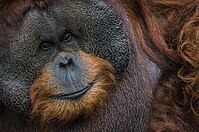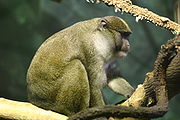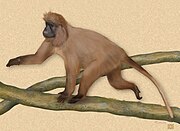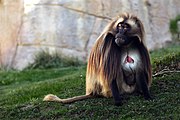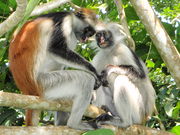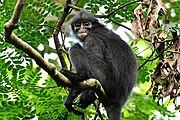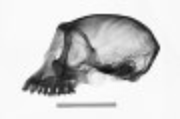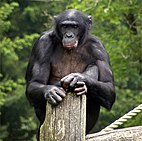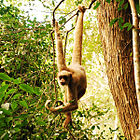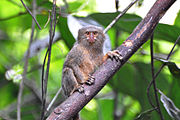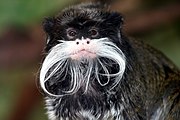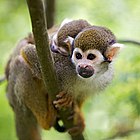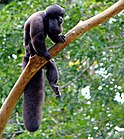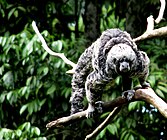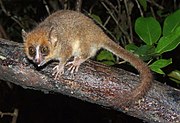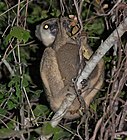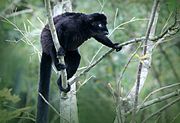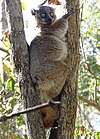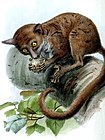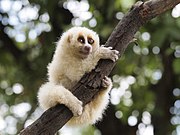Primates is a diverse order of placental mammals which includes monkeys, lemurs, galagos, lorisids, tarsiers, and apes (including humans). Members of this order are called primates. The order currently comprises 505 extant species, which are grouped into 81 genera. The majority of primates live in South and Central America, Africa, and southern and Southeast Asia, in a variety of habitats, particularly forests but also including grasslands, savannas, shrublands, wetlands, deserts, and rocky areas. The exception is humans, which have spread worldwide to every biome. Primates come in a variety of body plans but typically feature large brains, a shoulder girdle allowing a large degree of movement in the shoulder joint, dexterous hands, and tails, sometimes prehensile.[1] They range in size from Margot Marsh's mouse lemur, at 8 cm (3 in) plus a 11 cm (4 in) tail, to the eastern gorilla, at 196 cm (77 in), not including limbs. Primates are also the most intelligent animals and non-human primates are recorded to use tools, communicate with gestures and vocalizations, and have complex social systems.[2]
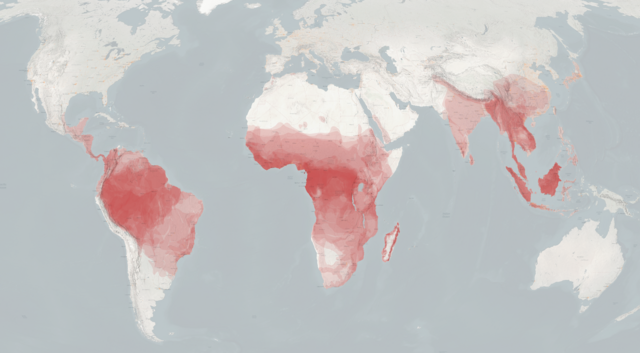
Primates is divided into two suborders: Haplorrhini and Strepsirrhini. The suborders are further subdivided into clades and families. Haplorrhini contains nine families in four major clades: Cercopithecoidea, containing the Old World monkeys of the family Cercopithecidae; Hominoidea, containing the great apes of the family Hominidae and the gibbons of the family Hylobatidae; Platyrrhines, or New World monkeys, divided into the families Aotidae, Atelidae, Callitrichidae, Cebidae, and Pitheciidae and containing night, howler, spider, woolly, capuchin, squirrel, and saki monkeys, marmosets, and tamarins; and Tarsiiformes, containing the tarsier family Tarsiidae. Strepsirrhini is split between two clades: Lemuroidea, divided into the families Cheirogaleidae (dwarf and mouse lemurs), Daubentoniidae (the aye-aye), Indriidae (wooly lemurs, sifakas, and indri), Lemuridae (lemurs), and Lepilemuridae (sportive lemurs); and Lorisoidea, split between the galago family Galagidae and the loris family Lorisidae. The exact organization of the species is not fixed, with many recent proposals made based on molecular phylogenetic analysis. No species have been recorded as going extinct since 1500 CE, but over 200 species, or more than 40 percent of all primates, are considered endangered or critically endangered.
Conventions
Range maps are provided wherever possible; if a range map is not available, a description of the collective range of species in that genera is provided. Ranges are based on the International Union for Conservation of Nature (IUCN) Red List of Threatened Species unless otherwise noted.
Classification
The order Primates consists of 505 extant species belonging to 81 genera. This does not include hybrid species or extinct prehistoric species. Modern molecular studies indicate that the 81 genera can be grouped into 16 families; these families are divided between two named suborders and are grouped in those suborders into named clades, and some of these families are subdivided into named subfamilies.
Suborder Haplorrhini
- Superfamily Cercopithecoidea
- Family Cercopithecidae (Old World monkeys)
- Subfamily Cercopithecinae (cercopithecine monkeys): 13 genera, 78 species
- Subfamily Colobinae (leaf-eating monkeys): 10 genera, 80 species
- Family Cercopithecidae (Old World monkeys)
- Superfamily Hominoidea (apes)
- Family Hominidae (hominids)
- Family Hylobatidae (gibbons): 4 genera, 20 species
- Parvorder Platyrrhines (New World monkeys)
- Family Aotidae (night monkeys): 1 genus, 11 species
- Family Atelidae
- Subfamily Alouattinae (howler monkeys): 1 genus, 12 species
- Subfamily Atelinae (spider and wooly monkeys): 3 genera, 11 species
- Family Callitrichidae (marmosets and tamarins): 7 genera, 43 species
- Family Cebidae
- Subfamily Cebinae (capuchin monkeys): 2 genera, 11 species
- Subfamily Saimiriinae (squirrel monkeys): 1 genus, 7 species
- Family Pitheciidae
- Subfamily Callicebinae (titi monkeys): 3 genera, 33 species
- Subfamily Pitheciinae (saki monkeys and uakaris: 3 genera, 25 species
- Infraorder Tarsiiformes
- Family Tarsiidae (tarsiers): 3 genera, 14 species
Suborder Strepsirrhini
- Superfamily Lemuroidea (lemurs)
- Family Cheirogaleidae (dwarf and mouse lemurs): 5 genera, 41 species
- Family Daubentoniidae (aye-aye): 1 genus, 1 species
- Family Indriidae (woolly lemurs, sifakas, and indri): 3 genera, 19 species
- Family Lemuridae (lemurs): 5 genera, 21 species
- Family Lepilemuridae (sportive lemurs): 1 genus, 25 species
- Superfamily Lorisoidea
- Family Galagidae (galagos): 6 genera, 19 species
- Family Lorisidae
- Subfamily Lorisinae (lorises): 3 genera, 11 species
- Subfamily Perodicticinae (angwantibos and pottos): 2 genera, 5 species
Primates
The following classification is based on the taxonomy described by Mammal Species of the World (2005), with augmentation by generally accepted proposals made since using molecular phylogenetic analysis, as supported by both the IUCN and the American Society of Mammalogists.[4]
Suborder Haplorrhini
Superfamily Cercopithecoidea
Family Cercopithecidae
Members of the Cercopithecidae family are called cercopithecids, or colloquially Old World monkeys, and include baboons, colobuses, guenons, lutungs, macaques, and other types of monkeys. Cercopithecidae comprises 158 extant species, divided into 23 genera. These genera are grouped into two subfamilies: Cercopithecinae, or cercopithecine monkeys, containing baboon, guenon, macaque, and other monkey species; and Colobinae, or leaf-eating monkeys, containing colobus, lutung, and other monkey species.
| Name | Authority and species | Range | Size and ecology |
|---|---|---|---|
| Allenopithecus | Lang, 1923
One species
|
Central Africa |
Size: 33–51 cm (13–20 in) long, plus 35–52 cm (14–20 in) tail[5] Habitats: Forest[6] Diet: Fruit, leaves, and small invertebrates[7] |
| Allochrocebus (terrestrial guenon) |
Elliot, 1913
Three species
|
Central and west-central Africa | Size range: 31–69 cm (12–27 in) long, plus 48–10 cm (19–4 in) tail (L'Hoest's monkey)[8] Habitats: Grassland and forest[9] Diets: Fruit, seeds, shoots, leaves, buds, flowers, mushrooms, and invertebrates[8] |
| Cercocebus (white-eyelid mangabey) |
É Geoffroy, 1812
Seven species
|
Equatorial Africa | Size range: 40–80 cm (16–31 in) long, plus 45–100 cm (18–39 in) tail (Golden-bellied mangabey)[10] Habitats: Inland wetlands, forest, shrubland, and savanna[10] Diets: Invertebrates, fruit, leaves, nuts, seeds, nectar, stems, roots, insects, fungi, grass, and small vertebrates[10] |
| Cercopithecus (guenon) |
Linnaeus, 1758
Nineteen species
|
Sub-Saharan Africa | Size range: 29 cm (11 in) long, plus 57 cm (22 in) tail (Lesser spot-nosed monkey) to 70 cm (28 in) long, plus 109 cm (43 in) tail (Blue monkey)[11] Habitats: Inland wetlands, forest, shrubland, and savanna[11] Diets: Fruit, leaves, seeds, shoots, herbs, invertebrates, flowers, buds, tree gum, birds, bird eggs, and small reptiles[11] |
| Chlorocebus (vervet monkey) |
Gray, 1870
Seven species
|
Equatorial, eastern, and southern Africa | Size range: 34 cm (13 in) long, plus 44 cm (17 in) tail (Malbrouck) to 83 cm (33 in) long, plus 114 cm (45 in) tail (Tantalus monkey)[12] Habitats: Forest, shrubland, and savanna[13] Diets: Fruit, leaves, flowers, small vertebrates, shoots, stems, roots, insects, bark, gum, eggs, invertebrates, pith, seeds, and mushrooms[12] |
| Erythrocebus (patas monkey) |
Trouessart, 1897
Three species
|
Equatorial and Eastern Africa | Size range: 49 cm (19 in) long, plus 43 cm (17 in) tail (Blue Nile patas monkey) to 70 cm (28 in) long, plus 70 cm (28 in) tail (Common patas monkey)[14] Habitats: Grassland, forest, shrubland, and savanna[15] Diets: Fruit, insects, gum, and arthropods, as well as flowers, fruit, seeds, leaves, stems, roots, small vertebrates, and bird eggs[14] |
| Lophocebus (crested mangabey) |
Palmer, 1903
Two species
|
Central Africa | Size range: 44–75 cm (17–30 in) long, plus 57–94 cm (22–37 in) tail (Grey-cheeked mangabey)[16] Habitats: Forest[16] Diets: Fruit and seeds[16] |
| Macaca (macaque) |
Lacépède, 1799
24 species
|
Southern, southeastern, and eastern Asia, and northwestern Africa | Size range: 36 cm (14 in) long, plus 36 cm (14 in) tail (Toque macaque) to 77 cm (30 in) long, plus 20 cm (8 in) tail (Arunachal macaque)[17] Habitats: Inland wetlands, rocky areas, shrubland, savanna, grassland, forest, intertidal marine, and caves[18] Diets: Fish, crabs, shellfish, bird eggs, honeycombs, invertebrates, gums, pith, seeds, leaves, flowers, dirt, fungi, and birds[17] |
| Mandrillus (mandrill) |
Ritgen, 1824
|
Western Africa | Size range: 55–95 cm (22–37 in) long, plus 7–10 cm (3–4 in) tail (Mandrill)[19] Habitats: Rocky areas, forest, and savanna[19] Diets: Omnivorous, primarily fruit and seeds[19] |
| Miopithecus (talapoin) |
Geoffroy, 1842
Two species
|
Western Africa | Size range: 23 cm (9 in) long, plus 31 cm (12 in) tail (Gabon talapoin) to 45 cm (18 in) long, plus 53 cm (21 in) tail (Angolan talapoin)[20] Habitats: Inland wetlands and forest[20] Diets: Insects, leaves, seeds, fruit, water plants, grubs, eggs, and small vertebrates[20] |
| Papio (baboon) |
Erxleben, 1777
Six species
|
Sub-Saharan Africa and southwestern Arabian Peninsula | Size range: 50–115 cm (20–45 in) long, plus 45–72 cm (18–28 in) tail (Chacma baboon)[21] Habitats: Inland wetlands, rocky areas, shrubland, savanna, desert, grassland, and forest[22] Diets: Fruit, leaves, roots, insects, eggs, small vertebrates, flowers, buds, grass, and seeds[21] |
| Rungwecebus | Davenport, 2006
One species
|
Southeastern Africa |
Size: 85–90 cm (33–35 in) long, plus about 115 cm (45 in) tail[23] Habitats: Forest[24] Diet: Omnivorous, including bulbs, roots, shoots, seeds, and fruit[23] |
| Theropithecus | Geoffroy, 1843
One species
|
Eastern Africa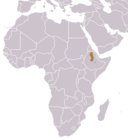 |
Size: 50–75 cm (20–30 in) long, plus 32–55 cm (13–22 in) tail[25] Habitats: Grassland and rocky areas[26] Diet: Leaves and forbs, as well as roots, corms, tubers and rhizomes[26] |
| Name | Authority and species | Range | Size and ecology |
|---|---|---|---|
| Colobus (black-and-white colobus) |
Illiger, 1811
Five species
|
Central Africa and Western Africa | Size range: 45–72 cm (18–28 in) long, plus 52–100 cm (20–39 in) tail (King colobus)[27] Habitats: Forest and savanna[28] Diets: Leaves, nuts, and seeds, as well as fruit, flowers, buds, stems, bark, shoots, insects, and clay[27] |
| Nasalis | É Geoffroy, 1812
One species
|
Borneo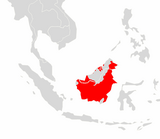 |
Size: 61–76 cm (24–30 in) long, plus 50–75 cm (20–30 in) tail[29] Habitats: Forest[30] Diet: Fruit, seeds, leaves, and shoots, as well as caterpillars and larvae[31] |
| Piliocolobus (red colobus) |
Rochebrune, 1887
Sixteen species
|
Congo, and eastern and western Africa | Size range: 41–70 cm (16–28 in) long, plus 42–80 cm (17–31 in) tail (multiple)[32] Habitats: Inland wetlands, forest, shrubland, and savanna[33] Diets: Leaves, fruit, shoots, buds, flowers, and seeds, as well as flowers[32] |
| Presbytis (surili) |
Eschscholtz, 1821
Nineteen species
|
Southeastern Asia | Size range: 42 cm (17 in) long, plus 50 cm (20 in) tail (Black Sumatran langur) to 62 cm (24 in) long, plus 85 cm (33 in) tail (Thomas's langur)[34] Habitats: Inland wetlands, forest, and shrubland[35] Diets: Fruit, leaves, seeds and flowers, as well as bark, twigs, stalks, birds, bird eggs, algae, and insects[34] |
| Procolobus | Rochebrune, 1877
One species
|
Western Africa |
Size: 43–50 cm (17–20 in) long, plus 57–64 cm (22–25 in) tail[36] Habitats: Forest[37] Diet: Leaves and flowers[38] |
| Pygathrix (douc) |
É Geoffroy, 1812
Three species
|
Southeastern Asia | Size range: 60 cm (24 in) long, plus 56 cm (22 in) tail (Black-shanked douc) to 77 cm (30 in) long, plus 77 cm (30 in) tail (Red-shanked douc)[39] Habitats: Forest[39] Diets: Leaves, as well as fruit, seeds, buds, and flowers[39] |
| Rhinopithecus (snub-nosed monkey) |
H. Milne-Edwards, 1872
Five species
|
Southern China, Central China, Northern Vietnam, and Northern Myanmar | Size range: 51 cm (20 in) long, plus 66 cm (26 in) tail (Tonkin snub-nosed monkey) to 83 cm (33 in) long, plus 72 cm (28 in) tail (Black-and-white snub-nosed monkey)[40] Habitats: Forest[41] Diets: Leaves, fruit, buds, flowers, buds, bark, seeds, and lichen, as well as insect larvae[40] |
| Semnopithecus (gray langur) |
Desmarest, 1822
Eight species
|
Sri Lanka, India, and Himalayas | Size range: 41–78 cm (16–31 in) long, plus 69–108 cm (27–43 in) (multiple)[42] Habitats: Rocky areas, forest, shrubland, and savanna[42] Diets: Leaves, fruit, and flowers, seeds, roots, bark, twigs, coniferous cones, moss, lichens, ferns, shoots, rhizomes, grass, and invertebrates[42] |
| Simias | Miller, 1903
One species
|
Islands near Sumatra in Indonesia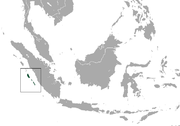 |
Size: 45–53 cm (18–21 in) long, plus 13–18 cm (5–7 in) tail[43] Habitats: Forest[44] Diet: Leaves, fruit, and berries[45] |
| Trachypithecus (lutung) |
Reichenbach, 1862
21 species
|
Southeastern Asia | Size range: 40–76 cm (16–30 in) long, plus 57–110 cm (22–43 in) tail (multiple)[46] Habitats: Inland wetlands, rocky areas, forests, forest, and caves[47] Diets: Leaves, flowers, fruit, shoots, seeds, and twigs, as well as bark and insects[46] |
Superfamily Hominoidea
Family Hominidae
Members of the Hominidae family are hominids, or colloquially great apes, and include gorillas, chimpanzees, orangutans, and humans. Hominoidae comprises eight extant species, divided into four genera. These genera are grouped into two subfamilies: Homininae, or African hominids, containing gorillas, chimpanzees, bonobos, and humans; and Ponginae, or Asian hominids, containing orangutans.
| Name | Authority and species | Range | Size and ecology |
|---|---|---|---|
| Gorilla (gorilla) |
Geoffroy, 1852
Two species
|
Central Africa and Western Africa |
Size range: 130 cm (51 in) long (Western gorilla) to 196 cm (77 in) long (Eastern gorilla)[48] Habitats: Forest[49] Diets: Leaves, berries, ferns, bark, roots, stems, and pith, as well as wood, flowers, fruit, fungi, galls, invertebrates, and gorilla dung[48] |
| Homo | Linnaeus, 1758
One species
|
Worldwide (population density shown) |
Size: 140–210 cm (55–83 in) long, including legs[50] Habitats: Varied Diet: Omnivorous |
| Pan (chimpanzee) |
Oken, 1816
Two species
|
Central and western Africa |
Size range: 63–90 cm (25–35 in) long (Chimpanzee)[51] Habitats: Forest and savanna[52] Diets: Fruit, leaves, stems, buds, bark, pith, seeds, and resins, as well as leaves, insects, shoots, small vertebrates, truffles, fungus, honey, and eggs[51] |
| Name | Authority and species | Range | Size and ecology |
|---|---|---|---|
| Pongo | Lacépède, 1799
Three species
|
Borneo and Sumatra |
Size range: 78–97 cm (31–38 in) long (Bornean orangutan)[53] Habitats: Forest[54] Diets: Fruit, leaves, shoots, flowers, and bark, as well as insects, sap, vines, spider webs, bird eggs, fungi, flowers, bark, and soil[53] |
Family Hylobatidae
Members of the Hylobatidae family are hylobatids, or colloquially gibbons. Hylobatidae comprises 19 extant species, divided into four genera.
| Name | Authority and species | Range | Size and ecology |
|---|---|---|---|
| Hoolock (hoolock gibbon) |
Mootnick & Groves, 2005
Three species
|
Southern Asia (in green) |
Size range: 45 cm (18 in) long (Western hoolock gibbon) to 81 cm (32 in) long (Skywalker hoolock gibbon)[55] Habitats: Forest[55] Diets: Fruit and leaves, as well as shoots, invertebrates, bird chicks, and flowers[55] |
| Hylobates (dwarf gibbon) |
Illiger, 1811
Nine species
|
Southeastern Asia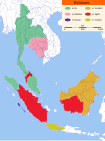 |
Size range: 42 cm (17 in) long (Silvery gibbon) to 65 cm (26 in) long (Agile gibbon)[56] Habitats: Forest[56] Diets: Fruit, flowers, leaves, and insects, as well as eggs and small vertebrates[56] |
| Nomascus (crested gibbon) |
Miller, 1933
Seven species
|
Southeastern Asia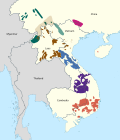 |
Size range: 40 cm (16 in) long (Eastern black crested gibbon) to 64 cm (25 in) long (Southern white-cheeked gibbon)[57] Habitats: Forest[57] Diets: Fruit, leaves, buds, shoots, and flowers, as well as insects, eggs, and small vertebrates[57] |
| Symphalangus | Gloger, 1841
One species
|
Southeastern Asia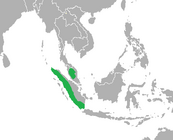 |
Size: 71–90 cm (28–35 in) long[58] Habitats: Forest[59] Diet: Fruit and leaves, as well as flowers and insects[59] |
Parvorder Platyrrhines
Family Aotidae
Members of the Aotidae family are aotids, or colloquially night monkeys. Aotidae comprises eleven extant species in a single genus.
| Name | Authority and species | Range | Size and ecology |
|---|---|---|---|
| Aotus (night monkey) |
Illiger, 1811
Eleven species
|
Central and northern South America and Central America | Size range: 24 cm (9 in) long, plus 31 cm (12 in) tail (Azara's night monkey) to 47 cm (19 in) long plus 42 cm (17 in) tail (Three-striped night monkey)[60] Habitats: Forest and savanna[60] Diets: Fruit, nectar, leaves, flowers, buds, and insects, as well as small vertebrates and eggs[60] |
Family Atelidae
Members of the Atelidae family are atelids, or colloquially night monkeys, and include howler, spider, woolly, and woolly spider monkeys. Aotidae comprises 24 extant species in 4 genera. It is divided into the subfamilies Alouattinae, or howler monkeys, and Atelinae, or spider and woolly monkeys.
| Name | Authority and species | Range | Size and ecology |
|---|---|---|---|
| Alouatta (howler monkey) |
Lacépède, 1799
Twelve species
|
Mexico, Central America, and northern, eastern, and central South America |
Size range: 38 cm (15 in) long, plus 52 cm (20 in) tail (Mantled howler) to 92 cm (36 in) long plus 92 cm (36 in) tail (Brown howler)[61] Habitats: Forest and savanna[61] Diets: Leaves, flowers, fruit, bark, and twigs as well as buds, seeds, moss, stems, termite nests, and decaying wood[61] |
| Name | Authority and species | Range | Size and ecology |
|---|---|---|---|
| Ateles (spider monkey) |
É Geoffroy, 1806
Seven species
|
Mexico, Central America, and northern and central South America | Size range: 30–63 cm (12–25 in) long, plus 63–84 cm (25–33 in) tail (Geoffroy's spider monkey)[62] Habitats: Forest[63] Diets: Fruit, leaves, flowers, nuts, seeds, and insects, as well as bark, honey, decaying wood, roots, fungi, arachnids, and eggs[62] |
| Brachyteles (muriqui) |
É Geoffroy, 1806
Two species
|
Southeastern Brazil | Size range: 46–50 cm (18–20 in) long, plus 72–81 cm (28–32 in) tail (both species)[64] Habitats: Forest[65] Diets: Leaves, fruit, vines, flowers, bark, nectar, and seeds[64] |
| Lagothrix (woolly monkey) |
É Geoffroy, 1812
Two species
|
Western South America | Size range: 44 cm (17 in) long, plus 60 cm (24 in) tail (Yellow-tailed woolly monkey) to 69 cm (27 in) long plus 72 cm (28 in) tail (Common woolly monkey)[66] Habitats: Forest and savanna[67] Diets: Fruit, leaves, insects, seeds, moss, buds, and flowers[66] |
Family Callitrichidae
Members of the Callitrichidae family are callitrichids, and include marmosets, tamarins, and lion tamarins. Callitrichidae comprises 43 extant species in 7 genera.
| Name | Authority and species | Range | Size and ecology |
|---|---|---|---|
| Callimico | Miranda-Ribeiro, 1922
One species
|
Western South America |
Size: 21–23 cm (8–9 in) long, plus 25–33 cm (10–13 in) tail[68] Habitats: Forest[69] Diet: Fruit, insects, and fungi, as well as lizards, frogs, and other small vertebrates[68] |
| Callithrix (Atlantic Forest marmoset) |
Erxleben, 1777
Six species
|
Eastern South America | Size range: 12 cm (5 in) long, plus 29 cm (11 in) tail (Common marmoset) to 30 cm (12 in) long plus 41 cm (16 in) tail (Buffy-headed marmoset)[70] Habitats: Forest and savanna[71] Diets: Plant gum, sap, fruit, flowers, nectar, seeds, insects, and spiders, as well as molluscs, small vertebrates, and bird eggs[70] |
| Cebuella (pygmy marmoset) |
Gray, 1866
Two species
|
Western South America | Size range: 12 cm (5 in) long, plus 17 cm (7 in) tail (Western pygmy marmoset) to 30 cm (12 in) long plus 41 cm (16 in) tail (Eastern pygmy marmoset)[72] Habitats: Forest[73] Diets: Tree gum, sap, and resin, as well as insects, small lizards, fruit, flowers, and spiders[72] |
| Leontocebus (saddle-back tamarin) |
Wagner, 1840
Seven species
|
Central and western South America | Size range: 17–31 cm (7–12 in) long, plus 25–44 cm (10–17 in) tail (multiple)[74] Habitats: Forest[74] Diets: Fruit, sap, nectar, vegetation, invertebrates, small vertebrates, and eggs[74] |
| Leontopithecus (lion tamarin) |
Lesson, 1840
Four species
|
Southeastern South America | Size range: 20 cm (8 in) long, plus 31 cm (12 in) tail (Black lion tamarin) to 37 cm (15 in) long plus 40 cm (16 in) tail (Golden lion tamarin)[75] Habitats: Forest[76] Diets: Spiders, snails, insects, small lizards, eggs, small birds, fruit, flowers, gum, nectar, and vegetables, as well as snakes and other small vertebrates[75] |
| Mico (marmoset) |
Lesson, 1840
Sixteen species
|
Central South America | Size range: 18–30 cm (7–12 in) long, plus 17–41 cm (7–16 in) tail (multiple)[77] Habitats: Forest, shrubland, and savanna[77] Diets: Sap, gum, fruit, seeds, nuts, insects, snails, spiders, leaves and small vertebrates[77] |
| Saguinus (tamarin) |
Hoffmannsegg, 1807
Seventeen species
|
Western, central, and eastern South America and southeastern Central America | Size range: 17–31 cm (7–12 in) long, plus 25–44 cm (10–17 in) tail (multiple)[78] Habitats: Forest and savanna[78] Diets: Fruit, sap, nectar, gum, seeds, flowers, invertebrates, small vertebrates, eggs, and soil[78] |
Family Cebidae
Members of the Cebidae family are cebids, and include capuchin and squirrel monkeys. Cebidae comprises eighteen extant species in three genera, and is divided into the subfamilies Cebinae, or capuchin monkeys, and Saimiriinae, or squirrel monkeys.
| Name | Authority and species | Range | Size and ecology |
|---|---|---|---|
| Cebus (gracile capuchin monkey) |
Erxleben, 1777
Four species
|
Northern and central South America and southeastern Central America | Size range: 30–57 cm (12–22 in) long, plus 30–56 cm (12–22 in) tail (Kaapori capuchin)[79] Habitats: Forest and savanna[80] Diets: Fruit, seeds, berries, nuts, figs, nectar, invertebrates, and small vertebrates[79] |
| Sapajus (robust capuchin monkey) |
Kerr, 1792
Seven species
|
Northern, central, and eastern South America |
Size range: 30–57 cm (12–22 in) long, plus 30–56 cm (12–22 in) tail (multiple)[81] Habitats: Forest, shrubland, and savanna[81] Diets: Fruit, seeds, nectar, pith, stems, nuts, berries, flowers, leaves, bird eggs, insects, frogs, small reptiles, birds, bats, other small mammals, oysters, and crabs[81] |
| Name | Authority and species | Range | Size and ecology |
|---|---|---|---|
| Saimiri (squirrel monkey) |
Voigt, 1831
Seven species
|
Northern and central South America and southern Central America | Size range: 22 cm (9 in) long, plus 37 cm (15 in) tail (Central American squirrel monkey) to 36 cm (14 in) long plus 43 cm (17 in) tail (Bare-eared squirrel monkey)[82] Habitats: Forest[82] Diets: Fruit, berries, seeds, nuts, gum, nectar, leaves, buds, flowers, insects, arachnids, bird eggs, and small vertebrates[82] |
Family Pitheciidae
Members of the Pitheciidae family are pitheciids, and include titis, saki monkeys and uakaris. Pitheciidae comprises 55 extant species in 5 genera, and is divided into the subfamilies Callicebinae, or titis, and Pitheciinae, or saki monkeys and uakaris.
| Name | Authority and species | Range | Size and ecology |
|---|---|---|---|
| Callicebus (Atlantic Forest titi monkey) |
Thomas, 1903
Five species
|
Eastern South America | Size range: 23–46 cm (9–18 in) long, plus 26–56 cm (10–22 in) tail (multiple)[83] Habitats: Forest, shrubland, and savanna[83] Diets: Fruit, leaves, flowers, seeds, and insects, as well as birds, vegetation, eggs, and small vertebrates and invertebrates[83] |
| Cheracebus (widow titi monkey) |
Byrne et al., 2016
Five species
|
Northern South America, Central South America, and Northwestern South America | Size range: 23–46 cm (9–18 in) long, plus 26–56 cm (10–22 in) tail (multiple)[84] Habitats: Forest and savanna[84] Diets: Fruit, seeds, leaves, stems, flowers, insects, spiders, and bird eggs[84] |
| Plecturocebus | Byrne et al., 2016
23 species
|
Northern, western, and central South America | Size range: 23–46 cm (9–18 in) long, plus 26–56 cm (10–22 in) tail (multiple)[85] Habitats: Forest and savanna[85] Diets: Fruit, flowers, seeds, leaves, vines, and insects, as well as arthropods, stems, shoots, eggs, and small vertebrates[85] |
| Name | Authority and species | Range | Size and ecology |
|---|---|---|---|
| Cacajao (uakari) |
Lesson, 1840
Seven species
|
Northern and western South America | Size range: 30–57 cm (12–22 in) long, plus 12–21 cm (5–8 in) tail (Aracá uakari)[86] Habitats: Forest and savanna[87] Diets: Fruit, nuts, seeds, flowers, leaves, nectar, insects, and arthropods[86] |
| Chiropotes (bearded saki) |
Lesson, 1840
Five species
|
Northern, northeastern, and central South America | Size range: 32 cm (13 in) long, plus 37 cm (15 in) tail (Black bearded saki) to 52 cm (20 in) long plus 51 cm (20 in) tail (Reddish-brown bearded saki)[88] Habitats: Forest[89] Diets: Fruit, seeds, nuts, flowers, and insects, as well as stems, arthropods, and leaves[88] |
| Pithecia (saki monkey) |
Desmarest, 1804
Thirteen species
|
Northern and central South America | Size range: 20 cm (8 in) long, plus 20 cm (8 in) tail (Napo saki) to 71 cm (28 in) long plus 55 cm (22 in) tail (Burnished saki)[90] Habitats: Forest[90] Diets: Seeds, fruit pulp, leaves, insects, and flowers[90] |
Infraorder Tarsiiformes
Family Tarsiidae
Members of the Tarsiidae family are tarsiids, or colloquially tarsiers. Tarsiidae comprises fourteen extant species in three genera.
| Name | Authority and species | Range | Size and ecology |
|---|---|---|---|
| Carlito | Groves & Shekelle, 2010
One species
|
Southeastern Philippines |
Size: 8–16 cm (3–6 in) long, plus about 25 cm (10 in) tail[91] Habitats: Forest[92] Diet: Insects, spiders, lizards, and other small vertebrates[91] |
| Cephalopachus | Swainson, 1835
One species
|
Western Philippines |
Size: 11–15 cm (4–6 in) long, plus 20–24 cm (8–9 in) tail[93] Habitats: Forest[94] Diet: Insects, as well as small vertebrates including birds, mammals, and reptiles[95] |
| Tarsius (tarsier) |
Storr, 1780
Twelve species
|
Sulawesi, Indonesia |
Size range: 8 cm (3 in) long, plus 20 cm (8 in) tail (Pygmy tarsier) to 15 cm (6 in) long plus 20 cm (8 in) tail (Siau Island tarsier)[96] Habitats: Inland wetlands, forest, and caves[96] Diets: Arthropods and insects, as well as small vertebrates[96] |
Suborder Strepsirrhini
Superfamily Lemuroidea
Family Cheirogaleidae
Members of the Cheirogaleidae family are cheirogaleids, and include dwarf, mouse, giant mouse, and fork-marked lemurs. Cheirogaleidae comprises 41 extant species in 5 genera.
| Name | Authority and species | Range | Size and ecology |
|---|---|---|---|
| Allocebus | Petter-Rousseaux & Petter, 1967
One species
|
Northeastern Madagascar |
Size: 12–15 cm (5–6 in) long, plus about 17 cm (7 in) tail[97] Habitats: Forest[98] Diet: Nectar, fruit, gum, leaves, honey, and insects[98] |
| Cheirogaleus (dwarf lemur) |
É Geoffroy, 1812
Ten species
|
Madagascar | Size range: 16 cm (6 in) long, plus 18 cm (7 in) tail (Ankarana dwarf lemur) to 27 cm (11 in) long plus 31 cm (12 in) tail (Greater dwarf lemur)[99] Habitats: Forest and shrubland[99] Diets: Fruit, flowers, leaves, seeds, nectar, and insects, as well as small vertebrates and honey[99] |
| Microcebus (mouse lemur) |
É Geoffroy, 1834
24 species
|
Madagascar |
Size range: 8 cm (3 in) long, plus 11 cm (4 in) tail (Margot Marsh's mouse lemur) to 16 cm (6 in) long plus 15 cm (6 in) tail (Anosy mouse lemur)[100] Habitats: Forest and shrubland[100] Diets: Gum, insect excretions, nectar, fruit, leaves, flowers, pollen, arthropods, and small vertebrates[100] |
| Mirza (giant mouse lemur) |
Gray, 1870
Two species
|
Western and northern Madagascar |
Size range: 23 cm (9 in) long, plus 31 cm (12 in) tail (Coquerel's giant mouse lemur) to 27 cm (11 in) long plus 32 cm (13 in) tail (Coquerel's giant mouse lemur)[101] Habitats: Forest[101] Diets: Fruit, flowers, insect secretions, sap, and invertebrates, as well as small vertebrates[101] |
| Phaner (fork-marked lemur) |
Gray, 1870
Four species
|
Western, northeastern, and northern Madagascar |
Size range: 22–29 cm (9–11 in) long, plus 28–37 cm (11–15 in) tail (multiple)[102] Habitats: Forest[102] Diets: Sap and gum, as well as insects, insect secretions, fruit, flowers, and nectar[102] |
Family Daubentoniidae
Members of the Daubentoniidae family are daubentoniids; the family comprises a single extant species, the aye-aye.
| Name | Authority and species | Range | Size and ecology |
|---|---|---|---|
| Daubentonia | É Geoffroy, 1795
One species
|
Western and eastern Madagascar |
Size: 36–44 cm (14–17 in) long, plus tail[103] Habitats: Forest and shrubland[104] Diet: Fruit, nuts, and sap[103] |
Family Indriidae
Members of the Indriidae family are indriids, and include woolly lemurs, sifakas, and indri. Indriidae comprises nineteen extant species in three genera.
| Name | Authority and species | Range | Size and ecology |
|---|---|---|---|
| Avahi (woolly lemur) |
Jourdan, 1834
Nine species
|
Madagascar |
Size range: 25 cm (10 in) long, plus 28 cm (11 in) tail (Betsileo woolly lemur) to 37 cm (15 in) long plus 35 cm (14 in) tail (Bemaraha woolly lemur)[105] Habitats: Forest[105] Diets: Buds and leaves, as well as flowers and fruit[105] |
| Indri | É. Geoffroy & G. Cuvier, 1796
One species
|
Northeastern Madagascar |
Size: 60–90 cm (24–35 in) long, plus 5–6 cm (2–2 in) tail[106] Habitats: Forest[107] Diet: Fruit, leaves, and flowers[106] |
| Propithecus (sifaka) |
Bennett, 1832
Nine species
|
Madagascar |
Size range: 42 cm (17 in) long, plus 50 cm (20 in) tail (Coquerel's sifaka) to 55 cm (22 in) long, plus 56 cm (22 in) tail (Diademed sifaka)[108] Habitats: Forest, shrubland, and savanna[108] Diets: Leaves, flowers, fruit, seeds, shoots, and bark, as well as soil[108] |
Family Lemuridae
Members of the Lemuridae family are lemurids, and include ring-tailed, true, ruffed, and bamboo lemurs. Indriidae comprises 21 extant species in 5 genera.
| Name | Authority and species | Range | Size and ecology |
|---|---|---|---|
| Eulemur (true lemur) |
Simons & Rumpler, 1988
Twelve species
|
Madagascar |
Size range: 30 cm (12 in) long, plus 40 cm (16 in) tail (Black lemur) to 51 cm (20 in) long plus 51 cm (20 in) tail (Common brown lemur)[109] Habitats: Forest[109] Diets: Leaves, fruit, buds, flowers, and pollen, as well as nectar, bark, insects, arthropods, fungi, and soil[109] |
| Hapalemur (bamboo lemur) |
Geoffroy, 1851
Five species
|
Western, northern, and eastern Madagascar |
Size range: 24 cm (9 in) long, plus 32 cm (13 in) tail (Southern lesser bamboo lemur) to 34 cm (13 in) long plus 41 cm (16 in) tail (Golden bamboo lemur)[110] Habitats: Inland wetlands and forest[110] Diets: Marsh plants, bamboo, grass, pith, stems, flowers, and leaves, as well as fruit, fungi, and soil[110] |
| Lemur | Linnaeus, 1758
One species
|
Southwestern Madagascar |
Size: 39–46 cm (15–18 in) long, plus 56–63 cm (22–25 in) tail[111] Habitats: Forest, shrubland, rocky areas, and caves[112] Diet: Omnivorous, including fruit, leaves, stems, flowers, sap, spiders, spider webs, chameleons, insects, small birds, and termite mounds[111] |
| Prolemur | Gray, 1871
One species
|
Eastern Madagascar |
Size: 40–45 cm (16–18 in) long, plus 43–48 cm (17–19 in) tail[113] Habitats: Forest[114] Diet: Bamboo shoots and pith, as well as flowers, leaves, soil, and fruit[113] |
| Varecia (ruffed lemur) |
Gray, 1863
Two species
|
Eastern Madagascar |
Size range: 45 cm (18 in) long, plus 60 cm (24 in) tail (Black-and-white ruffed lemur) to 50 cm (20 in) long plus 60 cm (24 in) tail (Red ruffed lemur)[115] Habitats: Forest[116] Diets: Fruit, nectar, and pollen, as well as leaves, flower, and seeds[115] |
Family Lepilemuridae
Members of the Lepilemuridae family are lepilemurids, or colloquially sportive lemurs. Lepilemuridae comprises 25 extant species in a single genus.
| Name | Authority and species | Range | Size and ecology |
|---|---|---|---|
| Lepilemur (sportive lemur) |
Geoffroy, 1851
25 species
|
Madagascar |
Size range: 23 cm (9 in) long, plus 26 cm (10 in) tail (Gray-backed sportive lemur) to 41 cm (16 in) long plus 27 cm (11 in) tail (Hawks' sportive lemur)[117] Habitats: Forest[117] Diets: Leaves, vines, fruit, flowers, spiders, and insects, as well as seeds, pollen, latex, and bark[117] |
Superfamily Lorisoidea
Family Galagidae
Members of the Galagidae family are galagids, or colloquially galagos or bush babies. Galagidae comprises nineteen extant species in six genera.
| Name | Authority and species | Range | Size and ecology |
|---|---|---|---|
| Euoticus (needle-clawed bushbaby) |
Gray, 1863
Two species
|
Western equatorial Africa | Size range: 18–33 cm (7–13 in) long, plus 28–31 cm (11–12 in) tail (Northern needle-clawed bushbaby)[118] Habitats: Forest[118] Diets: Tree gums and resins, as well as invertebrates[118] |
| Galago (lesser bushbaby) |
É Geoffroy, 1796
Four species
|
Equatorial and southern Africa | Size range: 13–21 cm (5–8 in) long, plus 19–30 cm (7–12 in) tail (Senegal bushbaby)[119] Habitats: Forest and savanna[120] Diets: Invertebrates, fruit, flowers, and gum, as well as small birds, eggs, and seeds[119] |
| Galagoides (western dwarf galago) |
A. Smith, 1833
Three species
|
Western and central equatorial Africa | Size range: 10 cm (4 in) long, plus 15 cm (6 in) tail (Prince Demidoff's bushbaby) to 18 cm (7 in) long plus 21 cm (8 in) tail (Angolan dwarf galago)[121] Habitats: Forest and shrubland[122] Diets: Insects, as well as fruit, gum, small vertebrates, tree buds, and leaves[121] |
| Otolemur (greater galago) |
Coquerel, 1859
Two species
|
Southern and eastern Africa | Size range: 23 cm (9 in) long, plus 36 cm (14 in) tail (Northern greater galago) to 38 cm (15 in) long plus 48 cm (19 in) tail (Brown greater galago)[123] Habitats: Forest, shrubland, and savanna[124] Diets: Gum, sap, fruit, and insects[123] |
| Paragalago (eastern dwarf galago) |
Masters, Génin, Couette, Groves, Nash, Delpero, & Pozzi, 2017
Five species
|
Southeastern Africa | Size range: 10 cm (4 in) long, plus 17 cm (7 in) tail (Rondo dwarf galago) to 19 cm (7 in) long plus 27 cm (11 in) tail (Grant's bushbaby)[125] Habitats: Forest[126] Diets: Fruit, gum, nectar, invertebrates, small vertebrates, and flowers[125] |
| Sciurocheirus (squirrel galago) |
Waterhouse, 1838
Three species
|
Western equatorial Africa | Size range: 15–24 cm (6–9 in) long, plus 20–30 cm (8–12 in) tail (Bioko Allen's bushbaby)[127] Habitats: Forest[128] Diets: Arthropods, insects, fruit, and gum, as well as small mammals[127] |
Family Lorisidae
Members of the Lorisidae family are lorisids, and include lorises, pottos and angwantibos. Lorisidae comprises sixteen extant species in five genera, and is divided into the subfamilies Lorisinae, or lorises, and Perodicticinae, or the angwantibos and pottos.
| Name | Authority and species | Range | Size and ecology |
|---|---|---|---|
| Loris (slender loris) |
É Geoffroy, 1796
Two species
|
Sri Lanka and Southern India | Size range: 18 cm (7 in) long with no tail (Gray slender loris) to 26 cm (10 in) long with no tail (Red slender loris)[129] Habitats: Forest[130] Diets: Insects, as well as tree frogs, geckos, small birds, eggs, and fruit[129] |
| Nycticebus (slow loris) |
É Geoffroy, 1812
Eight species
|
Southeastern Asia (blue and brown) |
Size range: 26 cm (10 in) long with no tail (Bangka slow loris) to 38 cm (15 in) long, with vestigial tail (Bengal slow loris)[131] Habitats: Forest[132] Diets: Resin, sap, gum, nectar, stems, fruit, invertebrates, lizards, bark, and bird eggs[131] |
| Xanthonycticebus | Nekaris & Nijman, 2022
One species
|
Southeastern Asia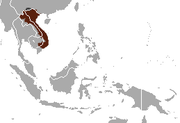 |
Size: 15–25 cm (6–10 in) long, with no tail[133] Habitats: Forest[134] Diet: Insects, gum, resin, fruit, and bamboo[133] |
| Name | Authority and species | Range | Size and ecology |
|---|---|---|---|
| Arctocebus (angwantibo) |
Gray, 1863
Two species
|
Western equatorial Africa | Size range: 22 cm (9 in) long, plus vestigial tail (Golden angwantibo) to 31 cm (12 in) long plus 10 cm (4 in) tail (Calabar angwantibo)[135] Habitats: Forest[136] Diets: Insects and fruit, as well as gum[135] |
| Perodicticus (potto) |
Bennett, 1831
Three species
|
Western and central Africa |
Size range: 29 cm (11 in) long, plus 4 cm (2 in) tail (East African potto) to 39 cm (15 in) long plus 10 cm (4 in) tail (West African potto)[137] Habitats: Forest[138] Diets: Fruit, gum, nectar, invertebrates, and eggs, as well as moss and small vertebrates[137] |
References
Sources
Wikiwand in your browser!
Seamless Wikipedia browsing. On steroids.
Every time you click a link to Wikipedia, Wiktionary or Wikiquote in your browser's search results, it will show the modern Wikiwand interface.
Wikiwand extension is a five stars, simple, with minimum permission required to keep your browsing private, safe and transparent.








